Feeling limited by your small patio, balcony, or urban yard? Vertical gardening transforms restrictive spaces into lush, productive gardens by growing upward instead of outward. This space-saving approach isn’t just practical—it’s also beautiful, efficient, and perfect for urban dwellers, apartment residents, or anyone with limited gardening space. In this comprehensive guide, we’ll walk through everything you need to know to create your own thriving vertical garden, from essential tools to plant selection and maintenance tips.
Why Vertical Gardening Is Perfect for Small Spaces
Vertical gardening isn’t just a trend—it’s a practical solution for modern living where outdoor space comes at a premium. By utilizing walls, fences, and vertical structures, you can dramatically increase your growing area while creating a stunning visual impact.
Key Benefits of Growing Upward
- Maximizes limited square footage by utilizing vertical space
- Improves air circulation around plants, reducing disease problems
- Makes harvesting and maintenance easier with less bending
- Creates privacy and blocks unsightly views
- Reduces water usage through more efficient irrigation systems
- Adds beauty and visual interest to plain walls and fences
- Keeps plants elevated from ground-dwelling pests
Ideal for Dry or Urban Environments
Vertical gardens are particularly valuable in dry climates or urban settings. When properly designed, they can use up to 90% less water than conventional gardens. Vertical systems can incorporate drip irrigation that delivers water directly to plant roots, minimizing evaporation and runoff. This targeted approach ensures plants receive consistent moisture without waste—perfect for water-conscious gardeners.
Additionally, vertical structures create microclimates that can protect sensitive plants from harsh sun or wind. By positioning your vertical garden strategically, you can create ideal growing conditions even in challenging environments.
Ready to Plan Your Vertical Garden?
Get our free Vertical Garden Planner with space-saving designs, plant selection guides, and printable maintenance schedules.
Essential Tools and Materials for Vertical Gardening
Setting up a vertical garden doesn’t require expensive equipment. With some basic tools and materials, you can create a thriving garden that fits your space and budget.

Beginner-Friendly Tools
- Support Structures: Trellises, wall-mounted grids, or freestanding towers to support climbing plants
- Containers: Hanging pots, wall planters, pocket planters, or stackable containers
- Fasteners: Plant ties, garden twine, or clips to secure plants to supports
- Irrigation: Drip irrigation kits or self-watering systems for consistent moisture
- Lightweight Soil Mix: Well-draining potting mix, often with perlite or vermiculite added
- Hand Tools: Pruners, trowel, and watering can with narrow spout
- Moisture Meter: To monitor soil moisture in containers that are difficult to check by touch
Budget-Friendly DIY Options
You don’t need to spend a fortune to start vertical gardening. Many effective systems can be created from repurposed items you might already have.
Pallet Planter
Transform a wooden pallet into a vertical garden with these simple steps:
- Sand rough edges and check for safe wood treatment
- Staple landscape fabric to the back and bottom
- Fill horizontal spaces with potting soil
- Plant herbs, strawberries, or flowers in the openings
- Lean against a wall or secure for stability
PVC Pipe Garden
Create a space-efficient vertical garden from PVC pipes:
- Cut 4-inch PVC pipe into 3-4 foot lengths
- Drill 3-inch holes along one side, spaced 8 inches apart
- Drill small drainage holes at the bottom
- Mount to a sunny wall with brackets
- Fill with potting mix and plant leafy greens or herbs
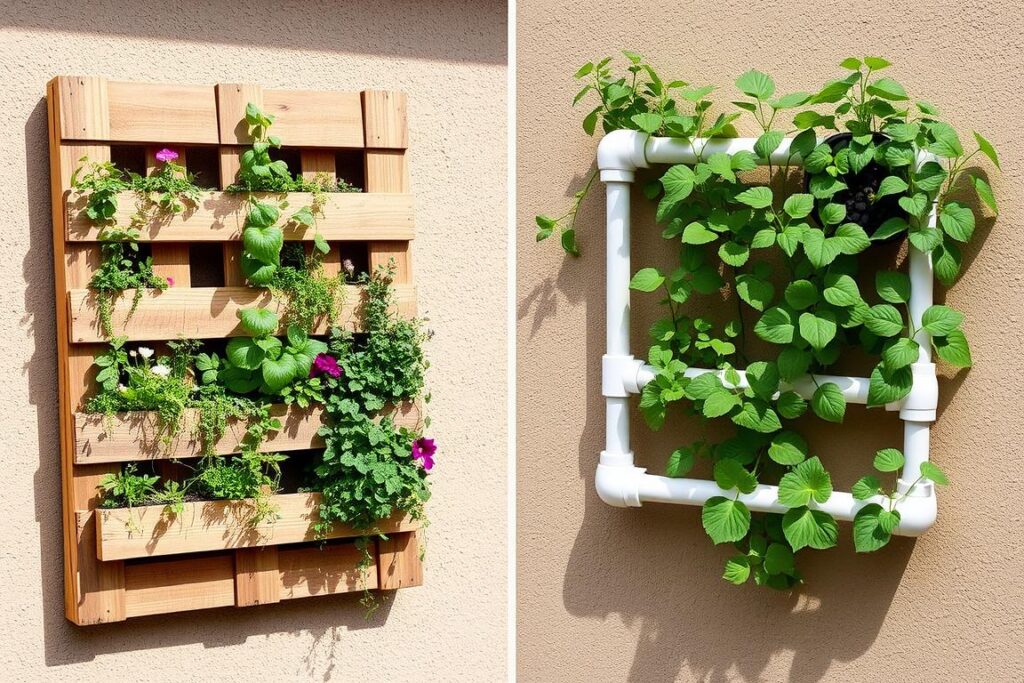
Step-by-Step Vertical Garden Setup Guide
Creating a successful vertical garden starts with proper planning and setup. Follow these steps to ensure your garden thrives from day one.
Choosing the Perfect Location
Location is critical for vertical garden success. Consider these factors when selecting your spot:
- Sunlight: Most vegetables and flowering plants need 6-8 hours of direct sunlight. Monitor your space to identify the sunniest spots.
- Wind Exposure: Excessive wind can dry out plants and damage structures. Choose a location with some protection or plan to create windbreaks.
- Accessibility: Ensure you can easily reach all plants for watering, harvesting, and maintenance.
- Wall/Surface Type: If mounting on a wall, ensure it can support the weight when plants are fully grown and watered.
- Water Source: Proximity to a water source will make maintenance much easier.
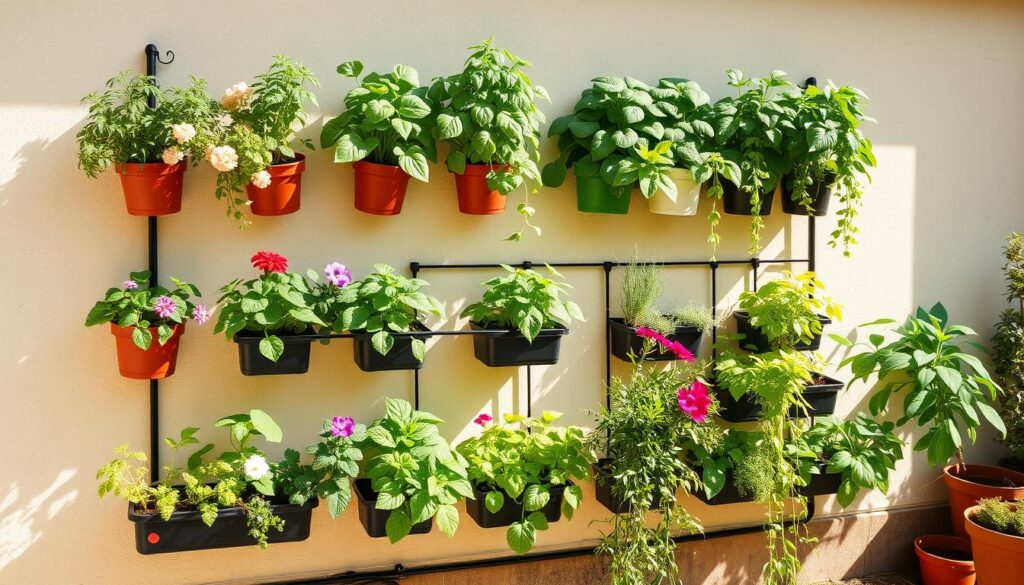
Installing Vertical Structures
Different vertical gardening systems require different installation approaches. Here are guidelines for the most common types:
Wall-Mounted Planters
- Mark mounting points with a level to ensure straight alignment
- Use appropriate anchors for your wall type (masonry, drywall, wood)
- Install planters with slight downward angle for drainage
- Leave adequate space between planters for plant growth
- Consider weight distribution across the wall
Freestanding Towers
- Choose a flat, level surface with good sun exposure
- Assemble according to manufacturer instructions
- Add weight to the base if needed for stability
- Position near a water source for easy irrigation
- Ensure 360-degree access for maintenance
Soil and Watering Systems
Vertical gardens have unique soil and watering needs compared to traditional gardens:
Lightweight Soil Mix Recipe
Create the perfect soil mix for vertical gardens with this ratio:
- 50% high-quality potting soil
- 30% coconut coir or peat moss for water retention
- 20% perlite or vermiculite for drainage and lightness
- Add slow-release fertilizer according to package directions
DIY Drip Irrigation System
A simple drip system ensures consistent watering with minimal effort:
- Connect a timer to your outdoor faucet
- Attach main water line tubing to the timer
- Run tubing along the top of your vertical garden
- Install drip emitters or soaker hose at plant locations
- Secure tubing with clips to prevent movement
- Set timer for early morning watering to reduce evaporation

Need Help Planning Your Setup?
Our Vertical Garden Planner includes detailed setup diagrams, material checklists, and step-by-step installation guides for different systems.
Best Plants for Vertical Gardens in Small Spaces
Not all plants are suitable for vertical gardening. The best choices are those that are lightweight, have shallow root systems, or naturally climb. Here’s a selection of plants that thrive in vertical gardens.
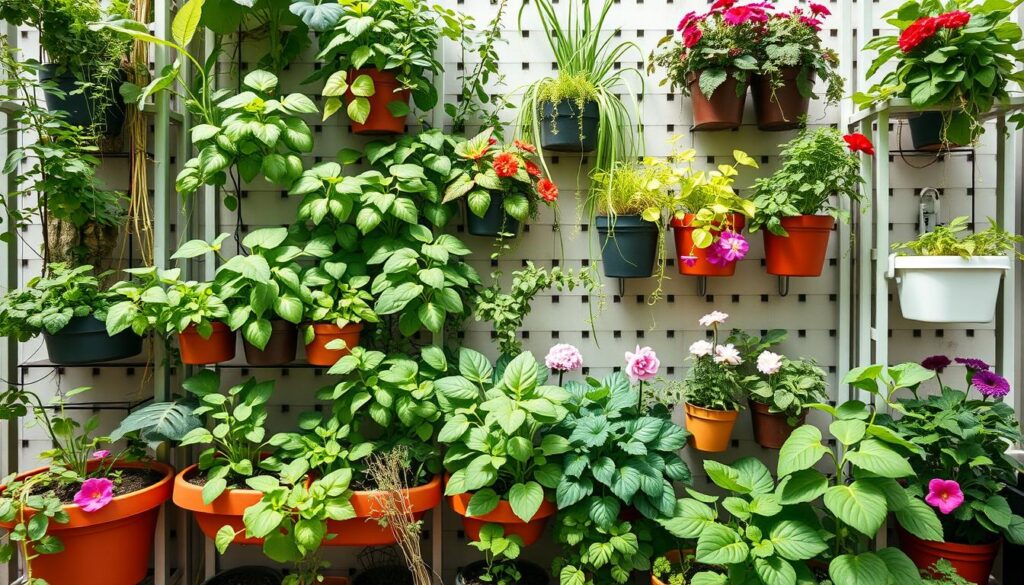
Drought-Tolerant Picks for Vertical Gardens
Herbs
- Rosemary: Aromatic, drought-resistant perennial
- Thyme: Low-water herb with compact growth
- Sage: Drought-tolerant with beautiful foliage
- Oregano: Spreads easily with minimal water
- Lavender: Fragrant and extremely drought-resistant
Vegetables
- Cherry Tomatoes: Compact varieties like ‘Tiny Tim’
- Lettuce: Shallow-rooted and perfect for wall pockets
- Peppers: Compact varieties work well in containers
- Cucumbers: Climbing varieties for trellises
- Pole Beans: Natural climbers that produce abundantly
Flowers & Ornamentals
- Succulents: Extremely drought-tolerant and lightweight
- Petunias: Cascading varieties for hanging planters
- Sweet Peas: Climbing flowers with beautiful fragrance
- Strawberries: Productive and attractive in hanging systems
- Ivy: Excellent for covering vertical surfaces quickly
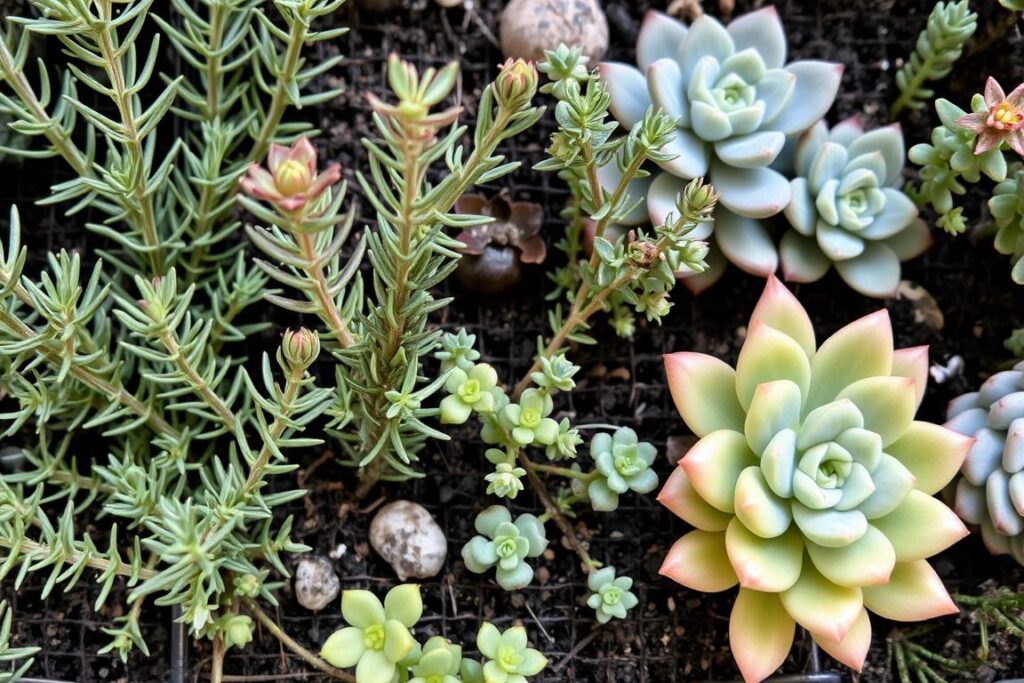
Plants to Avoid in Vertical Gardens
Some plants simply aren’t suited for vertical gardening due to their growth habits or needs:
- Corn: Too heavy and requires extensive root space
- Root vegetables: Carrots, potatoes, and other deep-rooting crops need more soil depth
- Large squash varieties: Heavy fruits can damage structures
- Tall sunflowers: Too top-heavy for most vertical systems
- Water-intensive plants: Rice or watercress require constant moisture
Not Recommended for Vertical Gardens
Perfect Plant Combinations
Create visually appealing and functional vertical gardens with these plant combinations:
| Garden Type | Top Section | Middle Section | Bottom Section |
| Culinary Herb Garden | Rosemary, Sage | Basil, Thyme, Oregano | Mint, Parsley, Cilantro |
| Salad Garden | Cherry Tomatoes | Cucumbers, Peppers | Lettuce, Spinach, Arugula |
| Ornamental Display | Climbing Roses, Jasmine | Petunias, Geraniums | Trailing Lobelia, Sweet Alyssum |
Vertical Garden Maintenance Tips
Proper maintenance ensures your vertical garden remains productive and attractive throughout the growing season. While vertical gardens typically require less maintenance than traditional gardens, they do have some specific needs.
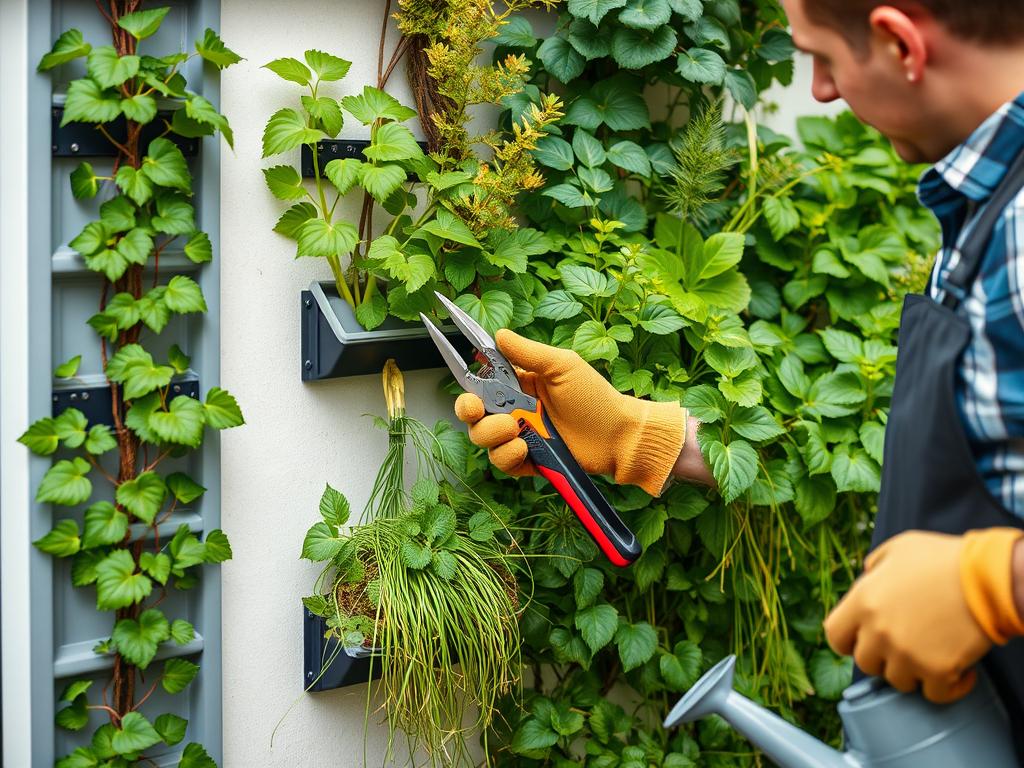
Watering Schedule for Vertical Gardens
Vertical gardens often dry out faster than ground-level gardens, especially in hot or windy conditions. Develop a watering routine that keeps plants consistently moist without overwatering.
Watering Tips for Dry Climates
- Water in early morning to reduce evaporation
- Check soil moisture daily during hot weather
- Install a moisture meter for containers that are difficult to check by hand
- Apply mulch to container surfaces to retain moisture
- Consider automated drip irrigation on a timer for consistent moisture
Different sections of your vertical garden may have different watering needs. Generally, plants at the top may need more frequent watering as gravity pulls water downward, while bottom containers may need better drainage to prevent waterlogging.
Pruning and Pest Control
Regular maintenance keeps your vertical garden healthy and productive:
Pruning Guidelines
- Trim climbing plants regularly to prevent them from becoming too heavy
- Remove dead or yellowing leaves promptly to prevent disease spread
- Pinch back herbs and leafy greens to encourage bushier growth
- Train vining plants along supports as they grow
- Harvest vegetables regularly to encourage continued production
Organic Pest Control Solutions
Vertical gardens typically have fewer pest problems than ground gardens, but they’re not immune. Try these organic solutions:
Prevention
- Inspect plants weekly for early signs of pests
- Maintain good air circulation between plants
- Attract beneficial insects with companion flowers
- Remove severely infested plants promptly
Treatment
- Spray strong streams of water to dislodge aphids
- Apply neem oil for multiple pest types
- Use insecticidal soap for soft-bodied insects
- Introduce beneficial insects like ladybugs
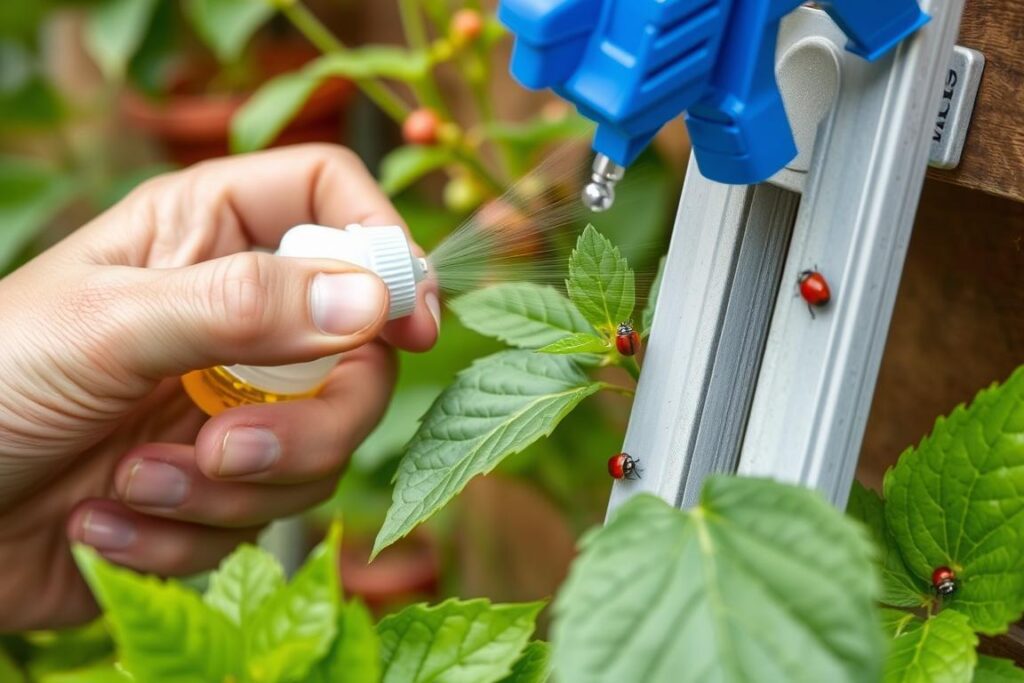
Seasonal Maintenance Calendar
Keep your vertical garden thriving year-round with these seasonal tasks:
| Season | Maintenance Tasks |
| Spring |
• Clean and repair structures • Replace soil in containers • Start seeds or plant seedlings • Set up irrigation systems |
| Summer |
• Monitor water needs daily • Harvest regularly • Apply liquid fertilizer monthly • Prune for airflow in hot weather |
| Fall |
• Harvest remaining crops • Remove annual plants • Plant cool-season crops • Reduce watering frequency |
| Winter |
• Protect structures from snow/ice • Move portable systems to sheltered areas • Maintain indoor vertical gardens • Plan next season’s layout |
Troubleshooting Common Vertical Garden Problems
Even well-planned vertical gardens can encounter issues. Here are solutions to the most common problems you might face.
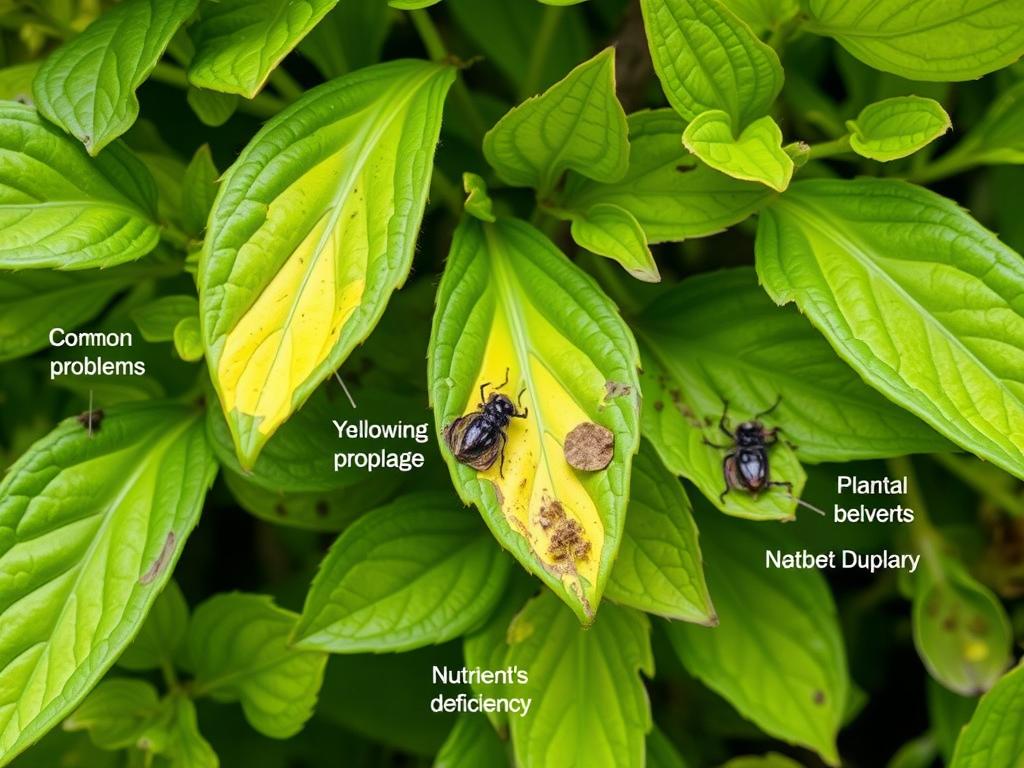
Why are my plants wilting despite regular watering?
Wilting despite moist soil often indicates root problems rather than dehydration. Check for:
- Poor drainage: Ensure containers have adequate drainage holes and that they’re not blocked
- Root rot: Overwatering can cause roots to rot. Allow soil to dry slightly between waterings
- Container size: Plants may be root-bound. Consider repotting into a larger container
- Heat stress: In extreme heat, plants may wilt temporarily even with adequate water. Provide afternoon shade if possible
Why are my vertical garden plants growing poorly with yellow leaves?
Yellowing leaves often indicate nutrient deficiencies, which are common in container gardens:
- Nitrogen deficiency: Overall yellowing, starting with lower leaves
- Iron deficiency: Yellowing between leaf veins while veins remain green
- Solution: Apply a balanced liquid fertilizer formulated for container plants every 2-4 weeks during the growing season
- Soil depletion: Container soil loses nutrients faster than ground soil. Replace or refresh soil annually
How do I prevent my vertical garden structures from falling or tipping?
Stability issues are common, especially as plants grow larger:
- Wall-mounted systems: Use appropriate anchors for your wall type and ensure they can support the weight when plants are fully grown and watered
- Freestanding structures: Widen the base or add weight to the bottom for better stability
- Wind protection: Position vertical gardens in areas protected from strong winds or secure them with additional supports
- Weight distribution: Place heavier plants at the bottom of the structure
Why aren’t my climbing plants growing up the supports?
Some climbing plants need assistance to find their supports:
- Training: Gently guide young stems toward supports and secure with plant ties or clips
- Support type: Different climbers prefer different supports. Tendrils need thin wires or string, while twining plants prefer larger poles
- Spacing: Ensure supports are close enough to the plant base for young plants to reach
- Growth stage: Some plants only begin climbing once they reach a certain maturity
How can I prevent water from dripping onto lower plants or the floor?
Water management is crucial in vertical gardens:
- Drip trays: Install trays under containers to catch excess water
- Staggered arrangement: Position plants so that lower ones aren’t directly under upper ones
- Controlled watering: Use drip irrigation or watering cans with narrow spouts for precise application
- Self-contained systems: Consider vertical garden systems with built-in water recirculation

Getting Started with Your Vertical Garden
Vertical gardening opens up a world of possibilities for growing plants in limited spaces. By thinking upward instead of outward, you can create a productive, beautiful garden regardless of your space constraints. Remember that successful vertical gardening is about starting small, learning as you go, and adapting to your specific conditions.
Begin with a simple system and a few reliable plants. As you gain confidence and experience, you can expand your vertical garden with more complex structures and a wider variety of plants. The key is to observe your plants closely, respond to their needs, and enjoy the process of creating your own green oasis in a small space.
With the right planning, tools, and maintenance, your vertical garden will not only maximize your limited space but also provide fresh produce, beautiful flowers, and a connection to nature right at your fingertips.
Ready to Transform Your Small Space?
Download our comprehensive Vertical Garden Planner with customizable templates, plant lists for different conditions, and season-by-season maintenance checklists.
Will is a vertical gardening enthusiast and sustainable cultivation specialist with a passion for helping people grow fresh food in small spaces and dry climates. With years of hands-on experience testing smart irrigation systems, optimizing urban gardens, and exploring eco-friendly solutions, this author shares clear, practical tips to turn any corner into a productive garden. Whether on a sunny balcony or in a compact backyard, Will helps readers save water, maximize space, and enjoy healthy harvests year-round. When not tending to his plants, you’ll find him sipping herbal tea and sketching ideas for new sustainable projects.

